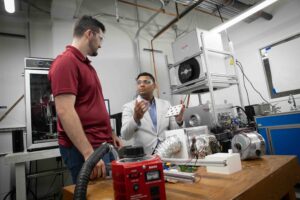
The idea of turning the air around us into drinking water is a marvel on its own. And grabbing a sustainable amount of it from low-humidity environments has long been closer to science fiction than reality.
As a megadrought stresses the water supply throughout the Southwest, revolutionary research out of University of Nevada, Las Vegas is answering this problem with a groundbreaking technology that pulls large amounts of water from the air in low humidity. The research, whose co-authors include University of Utah engineers, was published Oct. 22 in the journal Proceedings of the National Academy of Sciences (PNAS).
UNLV mechanical engineering professor H. Jeremy Cho leads a team of researchers with a radically different approach to atmospheric water harvesting, or transforming water vapor in the air around us into a usable form. Existing atmospheric water harvesting approaches have low yields and diminishing returns below 30% humidity.
“This paper really establishes that you can capture water at a very fast rate,” said Cho. “We can start to forecast how big of a system we would need to produce a set amount of water. If I have one square meter, which is around three feet by three feet, we can generate about a gallon of water per day in Las Vegas, and up to three times more in humid environments.”
This technology and approach has been tested outdoors in Las Vegas, and is effective down to 10% humidity. It directly captures water in a liquid salt solution that is suitable for subsequent processing into drinking water or energy production, enabling new capabilities for arid regions.
This work represents a significant shift in atmospheric water harvesting, opening doors to continuous operation and new applications of water production,” said co-author Sameer Rao, a U mechanical engineering professor. “These innovations are especially critical for the desert Southwest and its sustainability efforts.”
Rao’s Utah lab recently published a study that demonstrated the viability of a small portable device it designed, with funding from the U.S. Army, to draw drinking water from the atmosphere in arid places.
Continue reading at the University of Nevada, Las Vegas.